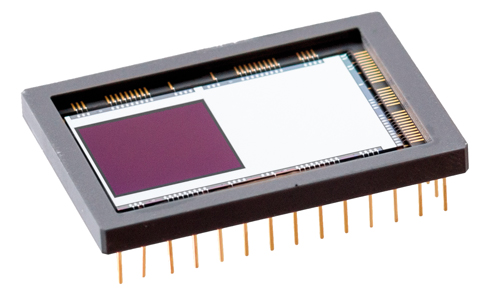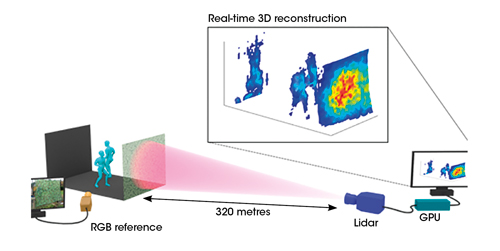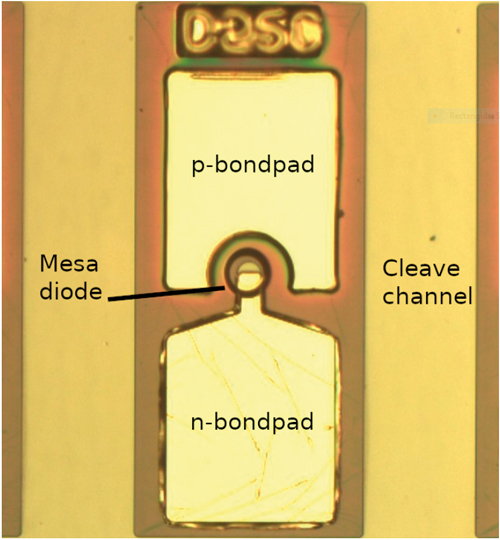In a world where it’s getting more common to use lasers to study our environment, researchers are seeking to reveal even more insights invisible to our naked eyes. Gerald Buller from Heriot-Watt University in Edinburgh, UK, gives the example of using light detection and ranging (lidar) technology to map foliage from above. ‘It’s not enough to take a camera and look at the top of the tree canopy because you don’t know what’s beneath it,’ said Buller.
Lidar seems to scatter photons across its surroundings with abandon, but Buller’s expertise is in detectors sensitive enough to count their return one by one. He highlights that such single photon detectors enable active lidar imaging that can use laser pulses to see further, or through obscuring layers like an upper leaf canopy. ‘For some applications, single photon takes it to the next level in terms of depth resolution and sensitivity,’ he said. ‘Sensitivity is important because it means that you can look at smaller optical signals. That directly corresponds to using the same laser power for going to longer distances. If you want to see through smoke and fog the single photon lidar approach is almost certainly going to be better.’
But today such single photon detectors only work for certain light wavelengths. In some applications, including defence and environmental monitoring, reaching up to 5µm would help. This is the aim of the Single Photons – Expanding the Spectrum (SPEXS) project, funded by the UK’s Engineering and Physical Sciences Research Council (EPSRC). SPEXS started in late 2019, and Buller is its principal investigator.
Buller explained that lidar measures the time of flight, during which a photon travels to a target and reflects or scatters back again. That provides the distance to an object, but relies on resolving a true signal from background noise. ‘The beauty of single photons is that you can have a highly sensitive return,’ he underlined. ‘You can also have a very high time resolution, pretty much better than any analogue non photon counting system, since this makes the signal large compared to the noise.’ Temporal resolution can go down to less than 100 picoseconds, which enables clear, concentrated signal detection against the background, Buller said. It is central to distinguishing photons that may be returning from obscured objects, such as lower levels of tree canopy.
Some examples of existing single photon detectors are silicon-based electron multiplying charge coupled devices (EMCCDs) available from UK-based Teledyne e2v. They are ‘widely used in the most sensitive applications in life science facilities and more recently in quantum technology research’, said Cliff Weatherup, Teledyne e2v’s strategic technology manager. ‘The wavelength range of silicon extends from the ultraviolet to the near infrared with a cut-off at 1,064nm.
‘There is a lot of interest in extending this detection capability out to the short-wave infrared and into the medium wave where there are a lot of performance benefits and some significant synergies with laser sources,’ Weatherup continued. ‘Teledyne has an ongoing interest in extending the capabilities in its current array detectors out to these longer wavelengths to drive technology advances in its existing markets and help extend our reach in new markets.’

Teledyne e2v already makes silicon-based electron multiplying charge coupled devices (EMCCDs) and is interested in extending its detection capability to the infrared
The shape of sensing to come
Time correlated single photon counting (TCSPC) is an increasingly well-established technique in lidar added Robert Lamb, chief technical officer, electro optics, at Leonardo in Edinburgh. This statistical sampling method records a photon’s arrival time with respect to a synchronisation signal, with picosecond temporal resolution. Its usage has expanded in many applications over the last decade, Lamb noted.
Leonardo’s interest is in defence, locating and identifying objects through their shape. Photon counting’s extreme sensitivity can capture very weak reflected signals. Its temporal precision helps enable this in 3D imaging lidar, with photon counting detector arrays. Where a photon returns in the array provides two-dimensional information in the horizontal xy plane. Highly sensitive detection of the time of flight gives accurate depth information along the z direction. ‘You’ve now got three dimensional information from which you’ve worked out a shape,’ he said.
Distributed reflection of a light pulse could provide a tree canopy’s density distribution, Lamb continued, which the European Space Agency (ESA) is interested in to survey biomass. Returning photons can be detected spectroscopically by satellites to track compositions of objects detected, like chlorophyll concentrations in leaves. ‘You could measure its seasonal variation, the health of the tree and therefore the health of an entire forest,’ Lamb emphasised. The light wavelength used in lidar determines which substances can be detected, and is one motivation for expanding the spectrum available in SPEXS.
Atmospheric transmission windows provide another motivation for spectrum expansion. Only certain light wavelengths can transmit through the atmosphere. Visible light is one, but lidar using that part of the spectrum could damage people’s eyes were the lasers to enter them. ‘The next atmospheric transmission window is in the shortwave infrared, which extends from around about 1.5µm to about 2.5µm,’ Lamb explained. However, single photon counting is much less mature in that region, he noted. As such, SPEXS is looking at different semiconductor technologies and superconducting wire technologies to improve single photon detectors performance for such wavelengths.
Lamb also warned that a potential weakness is the need to build up data to gain meaningful images and movies. ‘Often a single photon doesn’t tell you a great deal because it might not actually be a signal,’ he said. ‘It could be solar background or noise in the detector. To circumvent that you repeat the measurement and you build up the signal-to-noise ratio photon-by-photon. The general disadvantage is it takes time. Typical lidars might run at a few tens of hertz. In photon counting, it’s not unusual to be running at megahertz or tens of megahertz.’
Entering uncharted territory
Buller noted that processing the large amount of data generated has also been a limitation. However, he argues that progress has been made recently. For seeing through cloudy water, his team has produced videos using a pulsed picosecond laser diode source operating at 670nm and single photon avalanche diodes (SPADs). Buller and colleagues have also used infrared light to produce three-dimensional videos of people moving through obscuring screens. ‘3D movies that we’ve made of single photon-derived images in real time couldn’t have been done as recently as 18 months ago,’ he said. He added that SPEXS will also be looking at performance characteristics including single photon detection efficiency, dark count rate, operating temperature and temporal jitter. 
Gerald Buller from Heriot Watt University and colleagues have developed algorithms that process large amounts of data from single photon detectors in real time to produce 3D images of obscured objects
The transition from photomultipliers developed in the 1960s to SPADs demonstrated in the 1980s enabled current single photon lidar techniques. SPADs greatly amplify the electrons through the impact ionisation effect after incoming photons are absorbed within the semiconductor. ‘CMOS has meant that you can get pretty high frame rates, but silicon SPADs only work at shorter wavelengths,’ Buller said. More recently superconducting nanowire detectors have enabled short infrared wavelength detection in laboratory settings with excellent performance, but require cooling to very low temperatures. ‘That tends to mean there are issues of size, weight and power, which would make mobile applications difficult,’ Buller noted. ‘The Holy Grail is of course to do this at longer wavelengths, with semiconductor based detectors, preferably near room temperature.’ Buller had previously successfully developed such detectors based on InGaAs and InP. However their capabilities are limited, and they are relatively expensive. ‘We wanted to work with other materials to enhance the performance and increase the wavelength,’ he said.
As such, within SPEXS, Buller and colleagues are working on silicon-based multipliers, with germanium absorbers. ‘You get all the benefits of silicon multiplication, but you have an absorber with a narrower bandgap semiconductor, and that could get up to 1.6µm at room temperature,’ he said. ‘There may be ways of incorporating tin into germanium that could take it even further. The challenge is to try and get this to work near room temperature.’ Such a device might be relatively easy to manufacture, and UK researchers ‘have a lead’ on such research, Buller added. SPEXS therefore includes industrial partners who ‘might be interested in either forming a supply chain and or being end-users’.
Another strand of the SPEXS programme is being led by the University of Sheffield, based on detectors made solely from InAs. This semiconductor’s bandgap allows absorption up to 3.3µm wavelengths, which might enable remote spectroscopic sensing of greenhouse gases like carbon dioxide and methane, explained Sheffield researcher Jo Shien Ng. This spectral region is already covered by conventional InAs photodiodes for thermal imaging. ‘People don’t realise that it actually could also work very well as for avalanche photodiodes,’ added Ng’s colleague Chee Hing Tan. ‘We found some promising properties over 10 years ago. We continued to work on this material, which is quite tricky, so it took us quite a few years.’
Making it real
Tan explains that the InAs single photon detectors are effectively solid state versions of photomultiplier tubes. ‘It is very interesting for this project to see if it can produce the internal amplification without noise.’ The detectors can already detect signals comprising just 15 photons. To get sufficient gain to continue increasing the sensitivity involves achieving appropriate semiconductor doping profiles, Ng added.
Their InAs project will take place in two stages, revealed Tan. ‘The first phase would cover up to just over 3µm,’ he said. ‘Then there is a more ambitious phase of the project that aims to extend all the way to 5µm.’ That opens up spectroscopic possibilities, he observed, because many molecules absorb light in the 3-5µm range. Light in this spectrum can also penetrate smoke, and might be able to locate hotspots in forest fires, for example. Tan recognised that like InGaAs devices, such detectors will likely be expensive. ‘Right now our target has to be the high value market,’ he said. ‘Likely we are going to look at geospatial applications where the equipment is in the order of tens of thousands of pounds.’

The University of Sheffield is developing InAs single photon detectors
The wavelength range covered by SPEXS ‘is particularly relevant for the technical requirement of environmental monitoring,’ noted Teledyne e2v’s Weatherup. ‘Of equal importance is the translation of such technology to mainstream manufacturing for volume and cost benefits,’ he added.
That reflects Teledyne e2v’s advisory role in SPEXS. The company became aware of SPEXS as a strategic partner in the QuantIC Hub in Glasgow, UK, as a result of its interest in quantum technologies for a range of sensing and imaging innovations. ‘We engaged with Gerald and his team early in the process and became involved in technical exchanges to help develop our plans for future imaging sensors,’ Weatherup explained. ‘We are engaged in identifying collaboration and commercialisation opportunities that can be a practical route to achieving an economic impact from the programme. This is particularly focussed on the utilisation of our existing supply chain and in-house capabilities.’
Similarly, Leonardo is involved in the project as an interested potential user that could purchase detectors for its integrated systems. Leonardo has assessed commercially available single photon detection possibilities, Lamb explained. ‘We’ve understood, in certain cases, the limitations,’ he said. ‘When the UK government funds academia, it should be funding a new generation of detectors. I’ve certainly been very prominent in arguing the case for a UK supply chain to encourage the development of these technologies. Other people in industry have a similar view.’
Lamb is clear that SPEXS must have both academic and commercial partners. ‘When you transfer technology from academia into what is effectively engineering for the commercial market, one has to have a very clear idea of what the market demand is, what the market requirement is, and what the end use is going to be,’ he said. ‘The point about SPEXS is that there is an industrial advisory group. The academics get something out of it because they understand how that technology is to be used in a real application. Very often academics don’t fully appreciate the environment where their invention might have to work. And that’s where the commercial engineer steps in to make it a reality.’


